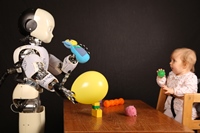iCub team wins UK science photography prize for second year running

‘iCub and the tutor’ by Sandy Spence Credit: Sandy Spence
21 March 2016
An image of a humanoid robot learning about how to play from a young child as part of robotics research at Aberystwyth University has won a top UK science photography award.
‘iCub and the tutor’ by Sandy Spence from the Department of Computer Science is the winner of the ‘People’ prize in this year’s Engineering and Physical Sciences Research Council (EPSRC) Science Photography Competition.
This is the second year in succession that Spence and colleagues have won the award.
In 2015 ‘The Greatest Discovery’ which showed the iCub humanoid robot ‘listening’ to the unborn child of mother to be Ayesha Jones, won the ‘People’ prize.
A year on, and Ayesha’s daughter Caiya features in ‘iCub and the tutor’, sitting at a table and playing with the iCub robot.
Both images were inspired by the work of the Intelligent Robotics Group at Aberystwyth University who are applying how young children learn about the world around them to the development of humanoid robots.
In 2015 the group was awarded £560,000 by the EPSRC for a three year research project that sees the group working with developmental psychologists to help robots learn more about the physics of objects and how to use objects as tools.
Patricia Shaw, a lecturer in Computer Science and a member of the Intelligent Robotics Group, explains: “During infancy, children learn from their experiences of the world around them. Through playing with objects they build up an understanding of what objects are and how to use them, along with concepts about the basic physics of the world such as object permanence.
“In this research, we are modelling how young infants learn and applying it to a humanoid robot. The aim is to develop a mechanism for robots to learn about the basic physics of the world through understanding objects. In ‘iCub and the tutor’, the iCub robot is learning about how to play from the baby.”
“We are delighted to have won this award for the second year running. It is recognition of the excellent work the team here at Aberystwyth University is doing, and offers us a great opportunity to share with everyone what we are working to achieve.”
The winners of the EPSRC Science Photography Competition have been announced today, Monday 21 March.
There were five categories in this year’s awards: ‘Eureka’, ‘Equipment’, ‘People’, ‘Innovation’, and ‘Weird and Wonderful’.
The over-all winner was ‘Microwave ion-trap chip for quantum computation’ by Diana Prado Lopes Aude Craik and Norbert Linke from the University of Oxford.
The other winners came from the University of Edinburgh, University of Cambridge and Imperial College London.
Competition judge, Professor Robert Winston, Professor of Science and Society and Emeritus Professor of Fertility Studies at Imperial College London, said: “It is crucial to promote greater understanding of science and engineering research, the role it plays in making new discoveries, developing new technologies and in making the world a better place for us all. These are truly inspirational images and tell great stories. It was a real pleasure to take part as a judge and I hope people will want to find out more.”
Congratulating the winners and entrants, Professor Philip Nelson, EPSRC’s Chief Executive, said: “Yet again, the standard of entries into this year’s competition shows the inquisitive, artistic and perceptive nature of the people EPSRC supports. I’d like to thank everyone who entered; you made judging a very hard but enjoyable task.
“This competition helps us engage with academics and these stunning images are a great way to connect the general public with research they fund, and inspire everyone to take an interest in science and engineering.”
The competition received over 200 entries which were drawn from researchers in receipt of EPSRC funding.
The judges were Martin Keene - Group Picture Editor - Press Association;
Professor Robert Winston - Professor of Science and Society and Emeritus Professor of Fertility Studies at Imperial College London
Professor Philip Nelson - EPSRC’s Chief Executive
The first, second and third prize winning images with descriptions are all available to download from the EPSRC website www.epsrc.ac.uk
AU11116



